ZX Spectrum graphic modes
The ZX Spectrum is generally considered to have limited graphical capabilities in comparison to some other home computers of the same era such as the Commodore 64, largely due to its lack of a dedicated graphics chip. Nevertheless, throughout its commercial life and later activity on the demoscene, various techniques have been developed to provide (or emulate) improvements to the Spectrum's graphical output.
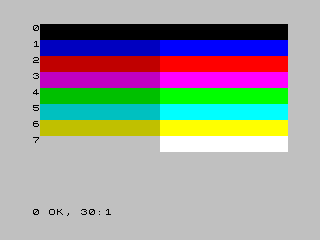
Colour palette
The ZX Spectrum (and compatibles) computers uses a variation of the 4-bit RGBI palette philosophy. This results in each of the colours of the 3-bit palette having a basic and bright variant, with the exception of black. The bright half of the palette is generated using the video display's maximum voltage levels for each of the three R/G/B colour components that a colour uses. The basic half of the palette is displayed by simply reducing these voltages.
In the ZX Spectrum encoding the colour components are in GRB order (from most to least significant bit) rather than the more common RGB order. The GRB order has the advantage that the colour numbers become ordered by increasing luminance, so if viewed on black-and-white display the ordered sequence 0 to 7 would form a gradient from black to white. Specifically, blue has a binary weight of 1, red has a weight of 2, and green has a weight of 4. As with any binary number, these weights add up to produce a single decimal number that matches the displayed colour, the effect of which can be seen in the table below (pay special attention to the "binary value" column).
For any value of n from 0 to 7, the following commands can be used to set or alter the screen's colours:
- BORDER n, the colour for surrounding area outside the main bitmap.
- PAPER n, the background (pixel bit value of 0) colour for the colour cell to be altered.
- INK n, the foreground (pixel bit value of 1) colour for the colour cell to be altered.
Furthermore, the BRIGHT command can be used to change the setting of the PAPER and INK commands' "bright" flag (the I in RGBI), giving them access to the entire 15-colour palette. Settings of "0" and "1" turn bright mode off and on (respectively). Since only one bit within a colour attribute byte is used to select the brightness for both foreground and background colours in a colour cell, it is not possible to select both bright and basic colour modes in the same colour cell. The BORDER command does not use a bright flag, thus only the eight basic colours are supported.
Counting from least to most significant bit, an attribute byte dedicates three bits for the foreground colour, three bits for the background colour, one bit for the bright flag, and one bit for the flashing effect (which causes the video display to alternate foreground and background colours periodically).
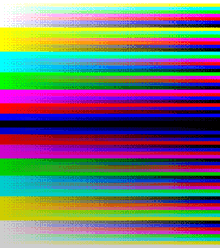
colour number Binary value BRIGHT 0 (RGB) BRIGHT 1 (RGB) colour name EGA/VGA 16col. equivalent BRIGHT 0 EGA/VGA 16col. equivalent BRIGHT 1 0 000 #000000 #000000 black 0 0 1 001 #0000D7 #0000FF blue 4 12 2 010 #D70000 #FF0000 red 1 9 3 011 #D700D7 #FF00FF magenta 5 13 4 100 #00D700 #00FF00 green 2 10 5 101 #00D7D7 #00FFFF cyan 6 14 6 110 #D7D700 #FFFF00 yellow 3 11 7 111 #D7D7D7 #FFFFFF white 8 15
BRIGHT BLACK colour was not in all models of ZX Spectrum and ZX Spectrum Emulators (but it is possible to regulate the palette in several emulators (ex. EmuZWin, ZX Spin), including bright black).
- colours simulated as RGB assume non bright as 85% voltage (0.55 V) and bright as 100% (0.65 V).[1] Viewing on a PAL display would be subject to gamma and as such the non bright values would appear lighter. Each ZX Spectrum model used different voltages for colours, so the values here are only indicative.
| 0,00,00 | 0,00,01 | 0,00,02 | 0,00,03 | 0,00,04 | 0,00,05 | 0,00,06 | 0,00,07 |
| 0,01,00 | 0,01,01 | 0,01,02 | 0,01,03 | 0,01,04 | 0,01,05 | 0,01,06 | 0,01,07 |
| 0,02,00 | 0,02,01 | 0,02,02 | 0,02,03 | 0,02,04 | 0,02,05 | 0,02,06 | 0,02,07 |
| 0,03,00 | 0,03,01 | 0,03,02 | 0,03,03 | 0,03,04 | 0,03,05 | 0,03,06 | 0,03,07 |
| 0,04,00 | 0,04,01 | 0,04,02 | 0,04,03 | 0,04,04 | 0,04,05 | 0,04,06 | 0,04,07 |
| 0,05,00 | 0,05,01 | 0,05,02 | 0,05,03 | 0,05,04 | 0,05,05 | 0,05,06 | 0,05,07 |
| 0,06,00 | 0,06,01 | 0,06,02 | 0,06,03 | 0,06,04 | 0,06,05 | 0,06,06 | 0,06,07 |
| 0,07,00 | 0,07,01 | 0,07,02 | 0,07,03 | 0,07,04 | 0,07,05 | 0,07,06 | 0,07,07 |
| 1,00,00 | 1,00,01 | 1,00,02 | 1,00,03 | 1,00,04 | 1,00,05 | 1,00,06 | 1,00,07 |
| 1,01,00 | 1,01,01 | 1,01,02 | 1,01,03 | 1,01,04 | 1,01,05 | 1,01,06 | 1,01,07 |
| 1,02,00 | 1,02,01 | 1,02,02 | 1,02,03 | 1,02,04 | 1,02,05 | 1,02,06 | 1,02,07 |
| 1,03,00 | 1,03,01 | 1,03,02 | 1,03,03 | 1,03,04 | 1,03,05 | 1,03,06 | 1,03,07 |
| 1,04,00 | 1,04,01 | 1,04,02 | 1,04,03 | 1,04,04 | 1,04,05 | 1,04,06 | 1,04,07 |
| 1,05,00 | 1,05,01 | 1,05,02 | 1,05,03 | 1,05,04 | 1,05,05 | 1,05,06 | 1,05,07 |
| 1,06,00 | 1,06,01 | 1,06,02 | 1,06,03 | 1,06,04 | 1,06,05 | 1,06,06 | 1,06,07 |
| 1,07,00 | 1,07,01 | 1,07,02 | 1,07,03 | 1,07,04 | 1,07,05 | 1,07,06 | 1,07,07 |
Dithering
This quite short colour palette has urged the graphic artists (e.g. at ZX-Art) to resort to various dithering techniques; the simplest of which employs ordered patterns, as shown exhaustively in the opposite chart. Dithering also works very well with the original Composite video connection to an analog PAL TV, generating colour mixing along horizontal pixel lines.
Standard mode
Hardware implementation
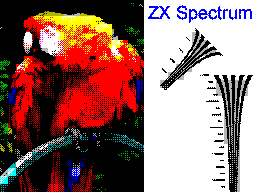
The original ZX Spectrum has a screen resolution of 256×192 pixels. Colour information is overlaid onto this as a grid of 8×8 pixel regions known as attribute blocks; within each attribute block, only two colours may be used out of a palette of 8 (black, blue, red, magenta, green, cyan, yellow and white). Additionally, the entire attribute block may be designated as 'bright', resulting in a total of 15 possible colours (because both bright and dark black is the same colour #000000). In many programs this limitation was evident as attribute clash.
- Details:
- Pixels: 256 × 192
- Attributes: 32 × 24
- colours: 15
Actual resolution over composite video connections
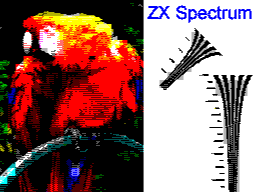
Due to the limitations of the original Composite video connection to an analogue PAL TV, adjacent pixels were in fact blurred out horizontally. The resulting resolution depended on the quality of the TV set and on the colour combinations used by each particular image, but on most cases was similar to ~128x192.
This effect was used to increase the number of displayed colours on screen by almost all of the graphic designers, using dithering techniques. Close to a total of 64 colours become possible this way. Some emulators provide some sort of "blur" image processing trying to simulate this effect.
- Details:
- Pixels: ~128 × 192
- Attributes: 32 × 24
- colours: ~128 (considering dither and bright/non bright colour variations)
Monochrome TVs and monitors
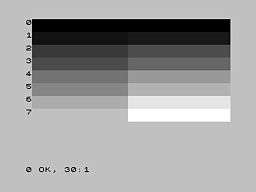
By using a monochrome monitor or black and white TV (or reducing the colour settings of a colour TV), it is possible to take advantage of the differences in intensity over the Spectrum's colour range to generate a 15-shade grayscale image at 256×192 resolution.
- Details:
- Pixels: 256 × 192
- Attributes: 32 × 24
- colours: 15 grayscale
Hicolour (8x1 attributes)
Hardware implementation
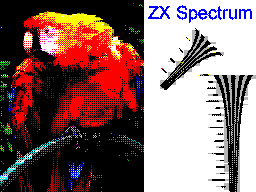
Several third-party Spectrum clones, including the Timex Sinclair machines and the Pentagon, support a screen mode in which attribute blocks are 8×1 pixels in size rather than the usual 8×8. A screen in this mode takes 12 KB RAM. In the case of the Timex, this mode is activated through the command OUT 255,2. In addition, this screen mode can be generated through the use of the MB03+ Ultimate interface, the MB-02 disk system's DMA hardware (where the technique is known as Multitech), and is also available as Mode 2 on the SAM Coupé.
- Details:
- Pixels: 256 × 192
- Attributes: 32 × 192
- colours: 15
Software implementation
"8x1" attributes
On other Spectrum models, this effect can be replicated by exploiting the fact that the ULA re-reads the attribute information on every pixel row when generating the video output; it is possible to write a new value to the relevant memory location in between successive lines, and thus cause a different pair of colours to be shown. However, the Spectrum's processor is not fast enough to write to an entire row of attribute bytes in one scanline, so 8×1 attributes can only be achieved over 20 columns.[2] This technique is variously known as Hicolour, Multicolour, FLI or Rainbow Processor mode.[3]
- Details:
- Pixels: 256 × 192
- Attributes: 32 × 192 (limited to a 18x192 area)
- colours: 15
"8x2" attributes
A variation on this method is to change the complete row of attributes over the course of two scanlines, resulting in 8×2 pixel attribute blocks over the full width of the screen.[4]
- Details:
- Pixels: 256 × 192
- Attributes: 32 × 96
- colours: 15
"4x1" attributes
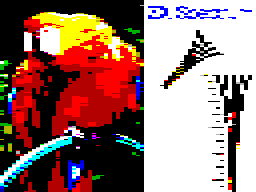
A special case involves alternating between the two available colours per attribute cell for 4 pixels each, allowing each 4×1 region to be treated as an independently colourable 'pixel' (although the limitation of one brightness level per 8×1 cell is still in effect).
- Details:
- Pixels: 64 × 192
- Attributes: 64 × 192
- colours: 15
ULAPlus
ULAPlus is compatible with the standard ZX Spectrum display, if used only to modify the 16 basic colours. Yet any software that uses the full 64 colours will trigger the "flash" attributes of the original Spectrum.
- Details:
- Pixels: 256 × 192
- Attributes: 32 × 24
- colours: 64 (from 256)
- Machine: ZX Spectrum SE, Chloe 280SE, Chloe 140SE, ZX-Uno (www.zxuno.com), zx128u+
- Interface: MB03+ Ultimate
Interlace/Switched modes
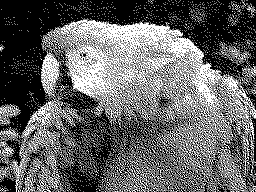
By alternating between two screens on every frame interrupt (50 Hz), it is theoretically possible to simulate a doubling of the vertical display resolution from 192 to 384 lines.
The Timex clones and ZX Spectrum 128K implement a 'shadow' screen area which can be switched into place through the use of a single OUT command, and this is often utilised to rapidly switch between two images for this purpose (although this can also be achieved with a standard block copy, albeit not over the entire screen).
When viewed on a CRT television screen (the standard at the time), the flicker is less noticeable than on a modern monitor. The image is linked to here (warning: the linked image flickers very rapidly, which could potentially cause seizures in people with photosensitive epilepsy).
The technique does not in fact achieve a true interlaced display, as the Spectrum lacks the ability to synchronise with the display hardware at such a low level. Rather, the effect is more akin to anti-aliasing, with certain pixels appearing at half intensity.[3]
- Details:
- Pixels: 256 × 384
- Attributes: 32 × 24
- colours: 15
GigaScreen
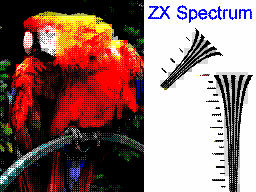
The attributes (colours) of an image are alternated at 50 Hz on the screen, taking advantage of the PAL colour system encoding for mixing. This way, the palette is increased to approximately 36 colours.[5]
For Pentagon machines, a hardware modification is available which directly combines the two alternate screen areas into the video signal, thus eliminating the flicker associated with this method. Furthermore, the gigascreen and hicolour techniques may be employed together to produce even richer-coloured images; this format has been named DithVIDE and BZither, both names referring to the dithering methods employed when converting true-colour images to the format.
- Details:
- Pixels: 256 × 192
- Attributes: 32 × 24
- colours: 36
3colour / Multichrome / RGB-3 / Interchrome
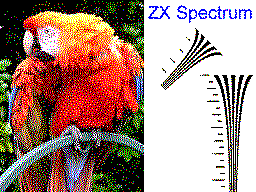
Three separate images, comprising a red, green and blue layer, are displayed on the screen rapidly, one after the other, relying on persistence of vision effects to merge the three layers into a single coloured image. The result is an 8-colour image where each pixel may be coloured independently.[6]
This effect is simulated in another image linked to here (warning: the linked image flashes colours very rapidly, which could potentially cause seizures in people with photosensitive epilepsy); the flashing is less noticeable when viewed on a television screen.
- Details:
- Pixels: 256 × 192
- Attributes: 256 × 192
- colours: 8
Emulated
256×192, 256 colours, "256 colour mode", no attributes
The SPEC256 and EmuZWin emulators have a screen mode 256×192 pixels where each pixel can be in one of 256 colours. This is achieved by extending the word size of the emulated Z80 from 8 bits to 64, making eight bits of data available for each pixel; the screen thus takes 48 KB of memory. This mode only exists on the emulator and software graphics must be modified to use it.
- Details:
- Pixels: 256 × 192
- Attributes: 256 × 192
- colours: 256
Compatible machines and interfaces
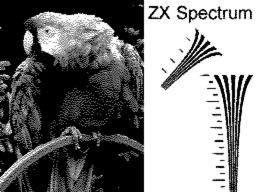
Later ZX Spectrum compatible machines offered extra video modes. These are based on the standard 256x192 mode but incompatible with the original Spectrum.[3] Also interfaces, the Spectra interface and the MB03+ Ultimate interface extend the Spectrum’s display to support more colours or/and extra video modes.
512×192 monochrome
This mode was mainly used to display 64×24 or 80×24 columns text screen and only Timex Sinclair computers and some Russian clones can display it. There are two graphics editors for this mode and it is supported by BASIC64 and some CP/M implementations. It also takes 12 KB (12 KiB) RAM.
- Details:
- Pixels: 512 × 192
- Attributes: none
- colours: 2 (Four palettes: Black & White, Blue & Yellow, Red & Cyan, Magenta & Green)
- Machine: Timex Sinclair, MB03+ Ultimate
512×192x4
- Details:
- Pixels: 512 × 192
- Attributes: 512 × 192
- colours: 4 (from 128) per line
- Machine: Sam Coupé
Layer 2 (256×192x256)
- Details:
- Pixels: 256 × 192
- Attributes: 256 × 192
- colours: 256
- Machine: ZX Spectrum Next
256×192x16
- Details:
- Pixels: 256 × 192
- Attributes: 256 × 192
- colours: 16 (from 128) per line
- Machine: Sam Coupé
384x304x16
- Details:
- Pixels: 384x304
- Attributes: 48 × 38
- colours: 16
- Machine: Pentagon
512x384x2
- Details:
- Pixels: 512 × 384
- colours: monochrome
- Machine: Pentagon, Timex Sinclair 2128
16c
- Details:
- Pixels: 256 × 192
- Attributes: 256 × 192
- colours: 16
- Machine: ATM Turbo, Pentagon
HAM256
- Details:
- Pixels: 256 × 192
- Attributes: 32 × 192
- colours: 32 per line (from 256)
- Machine: ZX Spectrum SE, ZX-Uno
Radastan
This mode displays 128x96 double sized pixels. Each pixel holds one of sixteen colours. Pixels are stored in linear buffer as 4-bit nibbles (i.e. 2 pixels per byte). The buffer is 6144 bytes long and occupies same memory as 256x192 pixel ram.
- Details:
- Pixels: 128x96
- Attributes: each pixel has separate colour
- colours: 16 (from 256)
- Machine: ZX-Uno
References
- http://www.zxdesign.info/ddrivedesign.shtml
- https://spectrumcomputing.co.uk/index.php?cat=96&id=30003
- http://8bit.yarek.pl/tool/zx.extra/index.html
- https://spectrumcomputing.co.uk/index.php?cat=96&id=30002
- http://gfxzone.planet-d.net/articles/zx_spectrum_graphics-article_01.html
- http://zxprism.blogspot.pt/2014/07/16-colour-colour-clash-free-planar-mode.html
External links
- ZX-Spectrum graphics modes
- ZX-Spectrum extra graphics modes
- Image to ZX Spec - An open source utility for image conversion from PC to ZX Spectrum (including 14 dither modes)
- Retro-X - A utility for image conversion from PC to old machines (includes non standard ZX Spectrum modes)
- ZX GIMP plug-in A GIMP plug-in to make any RGB image to look like a ZX Spectrum screen.
- BIFROST*2 Engine (Multicolour "8x1" attributes 20 columns)
- NIRVANA+ Engine (Multicolour "8x2" attributes full screen width)
- ZX-Spectrum graphic art collection